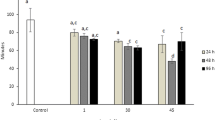Abstract
DNA-protein cross-links (DPXs) in fish erythrocytes represent a potential biomarker for exposure to metal cations, such as hexavalent chromium (Cr[VI]) and divalent nickel (Ni[II]). Species-specific sensitivities to DPX formation were studied by coexposure of juvenile specimens of rainbow trout, hybrid bluegill, and channel catfish to waterborne metals, such as Cr(VI) and Ni(II). In a species comparison, 4 days of exposure to 2 ppm Cr(VI) induced highest DPXs in bluegill erythrocytes, followed by trout and catfish, at 186%, 97%, and 48% above controls, respectively. A similar pattern of species sensitivity was observed following co-exposure of the fish to 15 ppm Ni(II) for 4 days, with 237%, 124%, and 82% increased DPXs above control bluegill, trout, and catfish, respectively. Biological stability of Cr(VI)-induced DPXs was demonstrated in Cr(VI)-exposed bluegill, as DPX levels remained elevated for up to 20 days after discontinuation of exposure. Similar results were found following exposure of catfish to Ni(II), with detectable DPXs found 10 days after acute exposure. In both bluegill and catfish, a continued increase in DPX formation in erythrocytes was seen for 5–10 days after Cr(VI) was removed from tank water, suggesting that residual Cr(VI) may be involved in DPX formation following acute exposure of fish.
Similar content being viewed by others
References
ATSDR (1990) Health assessment for Cherokee County-Galena subsite National Priorities List (NPL) site, Galena, Cherokee County, Kansas, Region 7. CERCLIS No. KSD980741862. NTIS PB90–112053. Agency for Toxic Substances and Disease Registry, Atlanta, GA
Barker S, Weinfeld M, Murray D (2005) DNA-protein crosslinks: their induction, repair, and biological consequences. Mutat Res 589:111–135
Barrie LA, Lindberg SE, Chan WH, Ross HB, Arimoto R, Church TB (1987) On the concentration of trace metals in precipitation. Atmos Environ 21:1133–1135
Borg H (1987) Trace metals and water chemistry of forest lakes in northern Sweden. Water Res 21:65–72
Byrne T, DeLeon IR (1986) Trace metal residues in biota and sediments from Lake Pontchartrain, Louisiana. Bull Environ Contam Toxicol 37:151–158
Camusso M, Vigano L, Balestrini R (1995) Bioconcentration of trace metals in rainbow trout: a field study. Ecotoxicol Environ Safe 31:133–141
Cary EE (1982) Chromium in air, soil and natural waters. In: Langard S (ed) Topics in environmental health. 5. Biological and environmental aspects of chromium. Elsevier Biomedical Press, New York, pp 49–64
Costa M, Zhitkovich A, Toniolo P (1993) DNA-protein crosslinks in welders: molecular implications. Cancer Res 53:460–463
Costa M, Zhitkovich A, Gargas M, Paustenbach D, Finlay B, Kuykendall J, Billings R, Wetterhahn K, Waalkes M, Patierno S (1997a) Interlaboratory validation of a new assay for DNA-protein crosslinks. Mutat Res 369:13–22
Costa M, Zhitkovich A, Harris M, Paustenbach D, Gargas M (1997b) DNA-protein cross-links produced by various chemicals in cultured human lymphoma cells. J Toxicol Environ Health 50:433–449
Dasch JM, Wolff GT (1989) Trace inorganic species in precipitation and their potential use in source apportionment studies. Water Air Soil Pollut 43:401–412
Kuykendall JR, Bogdannfy MS (1992) Reaction kinetics of DNA-histone crosslinking by vinyl acetate and acetaldehyde. Carcinogenesis 13:2095–2100
Kuykendall J, O’Neil S, Jarvi E (2004) Elevated DNA-protein cross-links in red blood cells of German carp, Cyprinus carpio, from the lower Passaic River, New Jersey. Bull Environ Contam Toxicol 73:898–902
Kuykendall JR, Miller KL, Mellinger KN, Cain AV (2006) Dietary hexavalent chromium exposure causes DNA-Protein crosslink formation in erythrocytes of largemouth bass (Micropterus salmonides). Aquatic Toxicol 28:27–31
Labarca C, Paigen K (1980) A simple, rapid, and sensitive DNA assay procedure. Anal Biochem 102:344–352
Medeiros MG, Rodrigues AS, Batoreu MC, Laires A, Rueff J, Zhitkovich A (2003) Elevated levels of DNA-protein crosslinks and micronuclei in peripheral lymphocytes of tannery workers exposed to trivalent chromium. Mutagenesis 18:19–24
Pane EF, Haque A, Wood CM (2004) Mechanistic analysis of acute, Ni-induced respiratory toxicity in the rainbow trout (Oncorhynchus mykiss): an exclusively branchial phenomenon. Aquat Toxicol 30:11–24
Pickering QH (1980) Chronic toxicity of hexavalent chromium to the fathead minnow (Pimephales promelas). Arch Environ Contam Toxicol 9: 405–413
Ramelow GJ, Webre CL, Mueller CS, Beck JN, Young JC, Langley MP (1989) Variations of heavy metals and arsenic in fish and other organisms from the Calcasieu River and Lake, Louisiana. Arch Environ Contam Toxicol 18:804–818
Shaham J, Bomstein Y, Gurvich R, Rashkovsky M, Kaufman Z (2003) DNA protein crosslinks and p53 protein expression in relation to occupational exposure to formaldehyde. Occup Environ Med 60:403–409
USGS (1989) Concentrations of nine trace metals in ground water at the Idaho National Engineering Laboratory, Idaho. U.S. Geological Survey. NTIS DE88015177. U.S. Geological Service, U.S. Department of Energy, Idaho Falls, ID
Wedrychowski A, Schmidt WN, Hnilica LS (1986) DNA-protein crosslinking by heavy metals in Novikoff hepatoma. Arch Biochem Biophys 251:397–402
World Health Organization (1988) Chromium. Environmental health criteria 61. WHO, Geneva, Switzerland
Zhitkovich A, Costa M (1992) A simple, sensitive assay to detect DNA-protein crosslinks in intact cells and in vivo. Carcinogenesis 13:1485–1489
Acknowledgments
J.R.K. was the 2005 recipient of the J. Bower, J. Bennett, and H. Bennett Endowed Chair for Pharmaceutical Research (College of Pharmacy, Ohio Northern University), which served as the primary support of this project. Much of this work was presented at the 45th Annual Meeting of the Society of Toxicology, San Diego, California, March 7, 2006 (Abstracts 1264, 1265, 1266, and 1267), and at the 9th International Conference of Environmental Mutagens, San Francisco, California, on September 6, 2005.
Author information
Authors and Affiliations
Corresponding author
Rights and permissions
About this article
Cite this article
Kuykendall, J.R., Miller, K.L., Mellinger, K.M. et al. DNA-Protein Cross-Links in Erythrocytes of Freshwater Fish Exposed to Hexavalent Chromium or Divalent Nickel. Arch Environ Contam Toxicol 56, 260–267 (2009). https://doi.org/10.1007/s00244-008-9175-9
Received:
Accepted:
Published:
Issue Date:
DOI: https://doi.org/10.1007/s00244-008-9175-9




